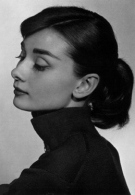Audrey Hepburn
Tribute to Audrey Hepburn
 Women's International Center Lovingly Dedicates Living Legacy Awards
2000 to "The Fairest Lady"
Women's International Center Lovingly Dedicates Living Legacy Awards
2000 to "The Fairest Lady"
Audrey Hepburn-Ruston was born May 4, 1929, near Brussels, Belgium. The daughter of an English banker and a Dutch baroness, she was sent to a girl's school near London after her parents' divorce. She was vacationing with her mother in Arnhem, Holland, when WW II broke out. She spent the war years in the Nazi-occupied town, attending a local public school and receiving ballet training at the Arhem Conservatory. After the war she went to London on a ballet scholarship. Graceful, slender, and long-legged, she soon began winning modeling assignments from fashion photographers. In the early 50s she joined Felix Aylmer's acting classes and began playing bit parts in British movies. While filming "Monte Carlo Baby" on the French Riviera, in 1951, she met Colette, the French novelist, who insisted that Audrey play the lead in the forthcoming Broadway adaptation of her "Gigi."
Fragile and radiant, projecting both childlike and feminine qualities, Miss Hepburn was an ideal Colette heroine. Her success in the play led to a starring part opposite Gregory Peck in the film "Roman Holiday," for which she won an Academy Award (she would later be nominated for Oscars four more times, for "Sabrina," "The Nun's Story," "Breakfast at Tiffany's," and "Wait Until Dark.") Six weeks after the Oscar ceremonies she won the Tony Award for her performance in the Broadway play "Ondine." Later in 1954 she married Mel Ferrer, her co-star in the play. They also co-starred in King Vidor's "War and Peace," she as Natasha and he as Andrei. Ferrrer later directed her in "Green Mansions" and produced her last picture of the 60's "Wait until Dark," for which she received her fifth Oscar nomination, for her portrayal of a terrorized blind woman. But Ferrer had no part in the real highlights of her career, notably "Funny Face," " Love in the Afternoon," "The Nun's Story," " Breakfast at Tiffany's," "Charade" and "My Fair Lady." They divorced in 1968. The following year she married an Italian psychiatrist nine years her junior and made her home in Rome and later in Switzerland. She was name a Special Ambassador for UNICEF and devoted much of her free time to charity. She returned to the screen in 1976 after a nine -year absence as a luminous 'Maid Marian' in "Robin and Marian," but her subsequent film appearances were few and far between. Shortly after a highly publicized 1992 mission of mercy to famine and war-torn Somalia, she died of colon cancer and the early age of 63. She was mourned internationally as the loss of one of the favorite film actresses of all time, an icon to style, elegance, dignity, and charity. (>From Ephriam Katz, The Film Encyclopedia)
Audrey Hepburn's farewell letter to her sons were from her favorite poem, she wrote "Remember, if ever you need a helping hand, it's at the end of your arm. As you get older, remember you have another hand: the first to help yourself, and second to help others."
Audrey Hepburn was a remarkable woman, an extraordinary human being, and a good and kind soul. Women's International Center is grateful to her son, Saun Ferrer for his kind assistance in helping to honor his beloved mother. We are proud to honor the legend and love of Audrey Hepburn.
To give to the Audrey Hepburn Children's Fund, log on to www.audreyhepburn.org.
[ WIC Main Page | Biographies |